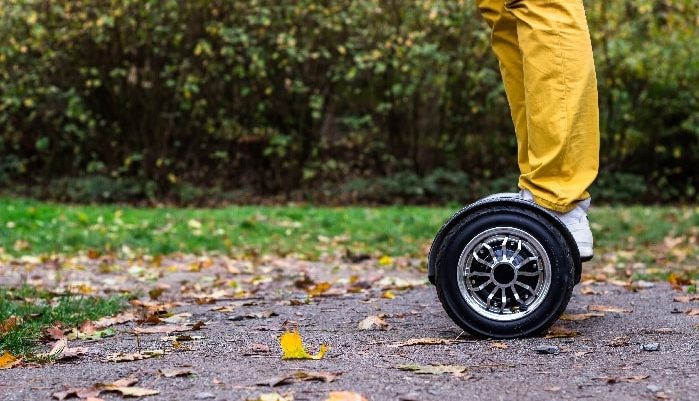Hoverboards and the Spike in Personal Injury Cases
Hoverboards — a wildly popular gadget that is much different than Marty McFly’s flying board shown off in Back to The Future. In 2015, this self-balancing scooter soared in popularity and it seems this trend is continuing with the newest 2016 models making their way to consumers. Everyone from high-profile celebrities to kids and their parents enjoy taking a ride on their hoverboards. While these hands-free electronic boards are the hottest craze among both children and adults, there are plenty of unseen hazards to enjoying the trendiest gadget of the moment.
After a slew of injuries including dangerous falls and hoverboards catching on fire, the U.S Consumer Product Safety Commission has devoted time to look at safety concerns regarding hoverboards. So, what does this mean for hoverboard users that have experienced a personal injury due to a hoverboard accident? Personal injury attorney, J. Price McNamara explains product liability and takes a look at some of the personal injury cases that are in the works due to hoverboard incidences.
Falls, Crashes, and Spontaneous Combustion with Hoverboards
Despite the name, hoverboards don’t actually levitate like the name suggests. This gadget can more accurately be described as a hands-free, motorized scooter. The premise to riding hoverboards is pretty simple; Lean forward to move forward, lean back to reverse, and slightly shift your weight to the right or left to steer. Although steering and operating a hoverboard may seem intuitive, being stable on the board is more difficult than you would expect. Some manufacturers even recommend having a spotter when you first get on the hoverboard because it will begin to excel as soon as you apply pressure.
The difficulty with riding a hoverboard is apparent when you look at the number of injuries that occur due to falls and collisions. In fact, hoverboards have been banned in places all around the world including parts of New York City, the University of California, Los Angeles campus, and the public streets of London. The popularity of hoverboards and the lack of regulations is a dangerous combination.
Adding to the obvious dangers of this trendy gadget, there have been many reports of hoverboards exploding. A Louisiana family lost their home after their son’s hoverboard caught fire while charging the battery. The mother reported that the board caught on fire so quickly that her house was in flames within a few minutes. Fires associated with hoverboards have been traced back to faulty batteries. The lithium-ion batteries that are used to power hoverboards can overheat in some instances and then catch fire. Major retailers like Amazon are erring on the side of caution with this product and offering a full refund for consumers that want to return their hoverboards.
Hoverboards and the Louisiana Products Liability Act
Fortunately, the Lafitte family sustained no injuries from the hoverboard fire. However, this brings up the question, who would legally be responsible if an injury had occurred? There are specific laws that create legal ramifications for manufacturers with defective goods that harm consumers. Louisiana created the Louisiana Products Liability Act, LPLA, in 1988 to address this exact concern.
A manufacturer that is liable for injuries is characterized as an entity that puts its name on a product label, a seller who controls the design or quality that causes an injury, or a seller that sells products made outside of the country.
In order to successfully use LPLA in court, you must prove several elements of the specific case. A successful claim would have to prove that a dangerous characteristic of a product caused damage during anticipated use, the product caused injuries without adequate warning or the dangerous aspect of the product existed while it was still in control of the manufacturer. If you’re able to prove that a manufacturer is liable for damages that occur under the LPLA, you can be compensated for emotional stress, pain and suffering, lost income from not working, medical bills, and wrongful death.
The
Consumer Product Safety Commission Chairman, Elliot F. Kaye announced last week that the CPCS staff is looking into the designs of hoverboards. Kaye stated that he didn’t believe manufacturers fully took into account how hoverboards would be affected by users at different weights.
The lack of regulations with hoverboards makes this product a personal injury lawsuit waiting to happen. It’s important to be aware of all of the safety concerns with this gadget and to be cautious with this purchase, especially if it’s a lower-end hoverboard in regards to combustion.
Contact J. Price McNamara ERISA Insurance Claim Attorney
With hundreds of falls or collisions and more than 40 hoverboard fires, this trendy gadget can certainly cause a significant amount of damage. If you’ve experienced a personal injury due to hoverboards or any other reason, contact J. Price McNamara ERISA Insurance Claim Attorney. You can seek compensation for you and your loved ones injury with the help of an experienced, knowledgeable attorney.
Contact our Baton Rouge, LA office today to schedule your free case review!
J. Price McNamara
Attorney
Losing my own brother, then my father and sister after long, disabling illnesses just a few months apart drove a career change for me. Before that experience, I never truly understood the place you’re in. I never understood the dramatic impact that receiving (or not receiving) the disability and life insurance benefits you paid for and counted on can have on your life especially when you need to focus on family and healing. What I experienced with my own family now drives the way I view my clients and my work, and I will never forget it!
Author's Bio



